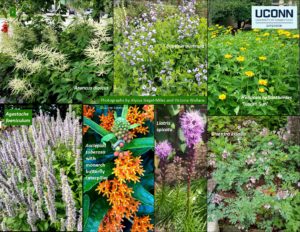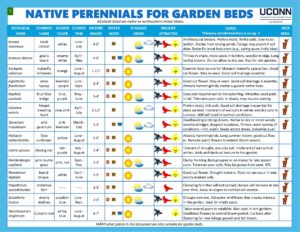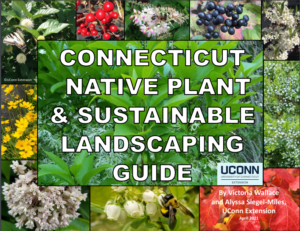 UConn Extension Releases Native Plant and Sustainable Landscaping Guide
UConn Extension Releases Native Plant and Sustainable Landscaping Guide
By Victoria Wallace and Alyssa Siegel-Miles
Interest in native plants and sustainable landscaping has exploded over the last decade. Through our UConn Extension Sustainable Turf & Landscape program, we provide practical, accessible, science-based information to support the sustainability goals of Connecticut green industry professionals, including golf course superintendents, sports turf managers, municipal and school grounds managers, and landscape contractors. Through our consultations, we interact with many gardeners and professionals who are seeking accurate, well-organized information on native plants and recommendations about how to incorporate them into the landscape. With this in mind, we developed the native plant and sustainable landscaping guide with 44 pages of plant lists for every location matched with vibrant photographs. The free guide can be downloaded at UConn Native Plant Guide
When designing landscapes with sustainability in mind, it is important to select plants that provide multiple benefits to the landscape, not only beauty – although MANY native plants certainly offer incredible aesthetic interest! Consider and select plants that are adapted to the existing soil conditions and microclimate, without supplemental water needs, so that soil amendments and inputs of fertilizer and irrigation can be reduced or eliminated. Prioritize the planting of native species, which have evolved in concert with native pollinators and wildlife, providing the foundation of local food webs that contribute to the restoration of local ecosystems and create conditions that support a wide variety of indigenous, beneficial animal and insect species.
The Native Plant & Sustainable Landscape Guide is a resource that will help garden enthusiasts and professionals identify plants that will thrive in the existing conditions and fill each niche in the garden. The guide is formatted like a calendar, with back-to-back pages intended for printing and displaying for easy viewing and frequent accessibility. Most plants listed in the guide are native to the Northeast United States. Some plants that are not native (but are not invasive) have also been included, because they offer qualities that are useful in a sustainable landscape, such as drought tolerance, salt tolerance, deer resistance, or other qualities of value. Plants that are not native to Northeastern U.S. are clearly labeled.
The guide lists plants by category, including native perennials for garden beds, low-growing ground covers, low-maintenance and alternative lawn options, forbs that grow easily by seed, tough native trees and shrubs, plants for reclamation areas, as well as plants that serve as cover crops or pasture crops. Each page lists the plant name, flower color, bloom time, mature height, water and sunlight needs, and provides information on the insects/pollinators the plant supports, deer resistance, and growing conditions. The guide also includes a list of native plant resources and nurseries, which are primarily Connecticut-based.
Many plants included in the document may be well known to ELA members, while many others may be new surprises to consider. For example, two pages highlight low-growing ground covers, with species including Prunus pumila var. depressa (creeping sand cherry), Rhus aromatica ‘Gro-Low’ (fragrant sumac), Sanguinaria canadensis (bloodroot), and Xanthorhiza simplicissima (yellowroot), which all are identified as attracting and supporting birds and bees. Ruellia humilis (wild petunia) and Zizia aurea (golden Alexander) both attract and support butterflies and bees. Growing information is also included, with interesting tidbits on each species: yellowroot has “excellent fall color,” Uvularia grandiflora (large-flowered bellwort) is a good cut flower but is “favored by deer.” Waldsteinia fragarioides (barren strawberry) is salt tolerant and sports evergreen foliage that “turns bronze in winter.”

Plant pictures from UConn Extension’s Native Plant & Sustainable Landscaping Guide.
This guide is a valuable resource for any gardener or landscape professional seeking to expand their knowledge and enhance their usage of native plants that will thrive and add value to the landscape. Plant lovers will enjoy reviewing the plant lists in the guide and finding inspiration from the beautiful photographs. The guide is available for free download here.

Charts from UConn Extension’s Native Plant & Sustainable Landscaping Guide, available for free download at ipm.uconn.edu.
About the Authors
Victoria (Vickie) Wallace serves as the statewide Extension Educator of Sustainable Landscapes for the University of Connecticut. With a focus on IPM as well as sustainable turf and landscape practices, she works closely with green industry professionals, including municipal and school grounds managers who require pesticide-free management programs to maintain their athletic fields and grounds. She evaluates turfgrasses for low input use and oversees a swallow-wort biological control research project.
Alyssa Siegel-Miles is a Research Technician for the Department of Extension and supports the Sustainable Landscape and IPM programs.
***
Each author appearing herein retains original copyright. Right to reproduce or disseminate all material herein, including to Columbia University Library’s CAUSEWAY Project, is otherwise reserved by ELA. Please contact ELA for permission to reprint.
Mention of products is not intended to constitute endorsement. Opinions expressed in this newsletter article do not necessarily represent those of ELA’s directors, staff, or members.

 UConn Extension Releases Native Plant and
UConn Extension Releases Native Plant and 